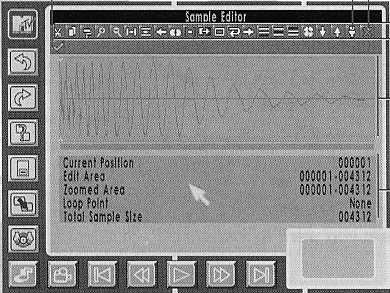Introduction - Editing Samples
To begin, Samples are quite simply recordings. Remember that
Riffs are a set of samples prioritized in a special order.
Samples are what riffs use to make a rhythm or sound. In order
to edit a sample you must be in the Riff Editor  menu. To edit a sample use circle in the Sample Palette to
select Edit Sample
menu. To edit a sample use circle in the Sample Palette to
select Edit Sample
The Tools
Along the top of the Sample Editor you will find a long row
of tools:

Below these will be a window which shows the wave of the
sample, and some technical information below that.
It is quite simple in how it works, you can select particular
portions of the sample, and trim, copy or cut the sections.
This is quite simple to do, so we'll start on the complex
stuff.
Filters
The filters are particularly interesting, as you can edit
them to a wide range of effects. The filters we should first
look at are:
- Low Pass
- Band Pass
- High Pass
The icons for these filters give you an idea of what they
do, the icons are a set of three bars, with two lines crossing
two of the bars. If you imagine these bars as sections of
the hearing range (20-20,000Hz) then you can see what they
do. The lines represent a cutoff.
These filters are very useful. The principal is, for example,
Band Pass, to eliminate particular spectrums of frequency
so that only the mid-range of frequencies are left. So if
you want to make a drum a little tighter and sharper, you
can apply a Band Pass filter. Further more, you can enhance
a persons voice, by first copying the sample, pasting it,
then applying a band pass filter to the original and then
pasting it next to the copied one.
Mixing
Mixing is a very good technique. The idea is to paste a part
of a sample over another part, with both pieces of information
overlaid. To do this, you first select a part of the sample,
copy it, then click the Mix button, this will over lay the
sample portion on top of the other one. A good tip is to Normalize
this, so it doesn't sound distorted.
Looping
Looping is a technique which lets you set a point where the
sample will return to, instead of starting back at the begging.
Say for example, you have a pad which begins as a loud crash
then a gentle drone. You can set a point after the crash so
that it appears as a long drone.
| 
